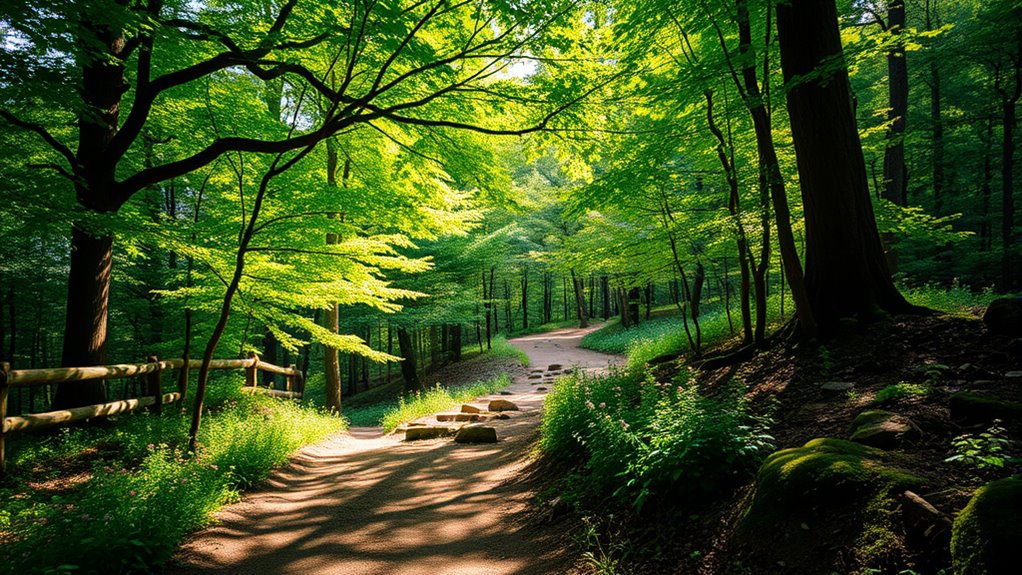To hike the Appalachian Trail responsibly, follow Leave No Trace principles by staying on designated paths, packing out all trash, and respecting wildlife and plant life. Plan your route carefully, carry the right gear, and be mindful of weather conditions. Respect quiet areas, set up camps in sustainable spots, and keep noise minimal. By practicing these habits, you safeguard the environment and ensure future hikers can enjoy the trail—explore further to learn more about these essential tips.
Key Takeaways
- Follow Leave No Trace principles by packing out trash, staying on trails, and respecting wildlife.
- Plan routes, check weather, and carry navigation tools to ensure safe, responsible hiking.
- Respect native plants and animals; observe from a distance and avoid disturbing habitats.
- Camp on durable surfaces, set up tents away from water sources, and leave no trace after camping.
- Use eco-friendly gear, minimize waste, and dispose of waste properly to protect the environment.
Understanding Leave No Trace Principles
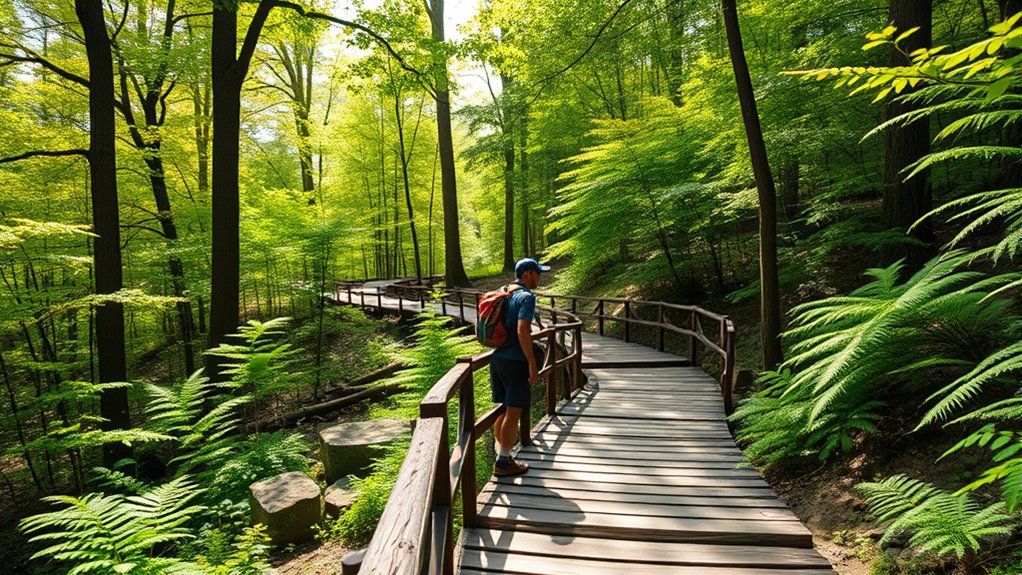
To protect the natural beauty of the Appalachian Trail, it’s essential that hikers understand and follow Leave No Trace principles. Proper campfire safety is vital; always use designated fire rings and keep fires small to prevent wildfires. When extinguishing your fire, make sure it’s completely out before leaving. Practicing good trail etiquette helps minimize impact—stay on established paths, yield to other hikers, and keep noise levels respectful. Pack out all trash, including food scraps, and avoid damaging plants or disturbing wildlife. Respect quiet areas and avoid creating new campsites. Additionally, understanding the financial impact of outdoor recreation can encourage responsible behavior that supports local economies and conservation efforts. By adhering to these principles, you guarantee the trail remains pristine for future hikers. Your responsible actions preserve the trail’s beauty and support a sustainable hiking experience.
Planning Ahead for Responsible Hiking
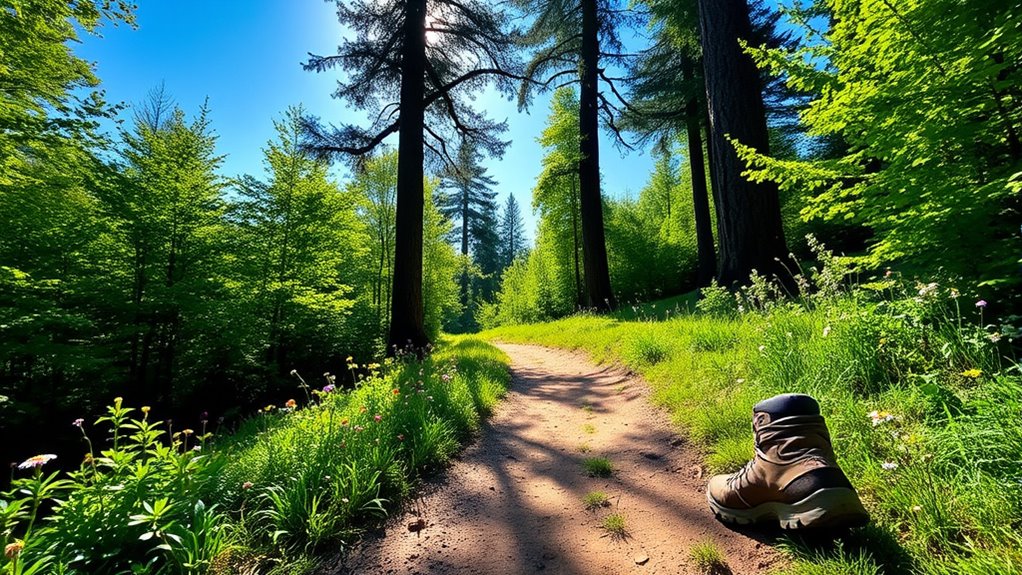
Proper planning guarantees your hike is safe, enjoyable, and minimizes environmental impact. Before hitting the trail, familiarize yourself with trail etiquette to respect fellow hikers and preserve the trail’s integrity. Prepare your gear, pack sufficient water, and plan your route to avoid getting lost or overexerted. Check weather forecasts and trail conditions to ensure wilderness safety, and always carry a map, compass, or GPS device. Know your limits and plan rest stops to prevent exhaustion. Inform someone about your itinerary, especially on remote sections. Being prepared helps you navigate the trail responsibly, reducing the risk of accidents and environmental damage. Incorporating projector setup considerations into your planning can also enhance your outdoor experience by providing clear visuals during nighttime or shelter use. Thoughtful planning enhances your experience while ensuring you leave minimal impact on the natural surroundings.
Respecting Local Wildlife and Plant Life

As you hike the Appalachian Trail, respecting local wildlife and plant life is essential to preserving the trail’s natural beauty. You can participate in flora preservation by staying on designated paths and avoiding picking plants. Practice responsible wildlife observation by keeping a respectful distance, never feeding animals, and using binoculars for a closer look. Keep noise levels low to avoid disturbing habitats. Remember these key points:
Respect wildlife and plants by staying on trails, observing quietly, and avoiding disturbance.
- Stay on marked trails to protect delicate plants and prevent erosion
- Observe animals quietly from a distance without interfering
- Do not pick or disturb native plants or flowers
- Dispose of waste properly to keep habitats clean and safe
- Be aware of paint sprayer technology that helps minimize environmental impact by reducing overspray and waste during maintenance activities.
Managing Waste and Minimizing Waste Impact
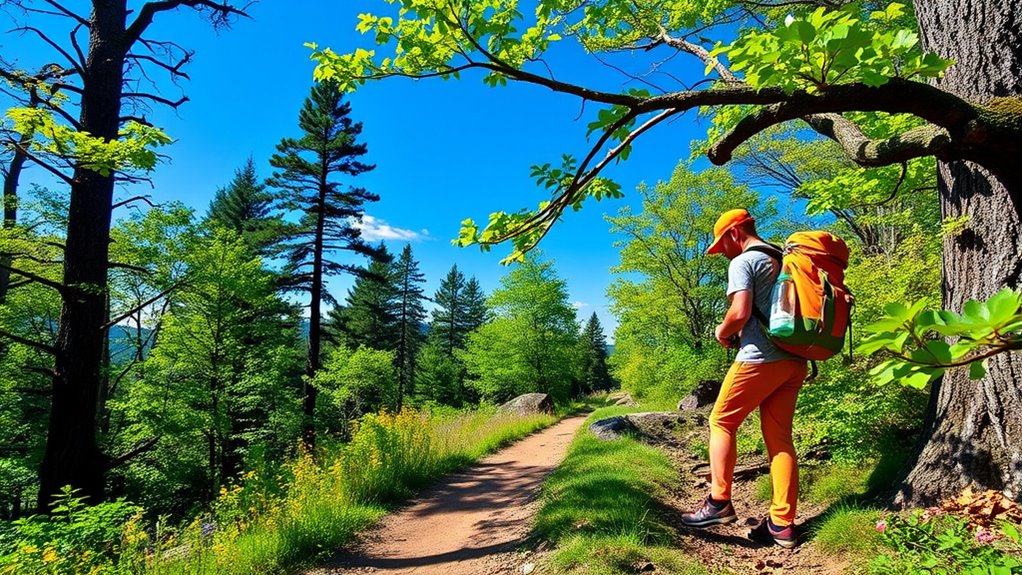
Managing waste effectively is essential to keeping the Appalachian Trail pristine for future hikers and wildlife. Always remember to pack it out—carry trash, leftover food, and toilet paper with you until you find proper disposal. Using eco friendly gear, like biodegradable soap and reusable containers, reduces your environmental impact. Minimize waste by planning your meals and avoiding single-use items. Proper waste management prevents pollution, protects plant and animal habitats, and preserves the trail’s natural beauty. Be mindful of where you dispose of waste, and avoid leaving anything behind. Your efforts in responsible waste management ensure the trail remains clean and enjoyable for everyone. Incorporating waste reduction techniques can also contribute to sustainable outdoor practices, helping to maintain the trail’s ecological health. By adopting these habits, you help maintain the integrity of this iconic wilderness for generations to come.
Staying on Designated Trails and Campsites

Staying on designated trails and campsites helps protect the natural environment you’ve worked to preserve. By following trail etiquette and choosing proper campsites, you minimize your impact on fragile ecosystems. When you stick to marked paths, you prevent erosion and protect plant life. Proper campsite selection means setting up away from water sources and avoiding damage to vegetation. Imagine walking along a well-maintained trail, where signs guide your way, and campsites are reserved for hikers like you. Using self-watering planters as an analogy, consistent and responsible choices in trail use help maintain the area’s health and beauty over time.
- Walking on the trail without shortcuts
- Respecting signs and barriers
- Setting up tents on durable surfaces
- Leaving no trace after camping
Adhering to these practices ensures the trail remains pristine for future hikers and preserves the wilderness’s integrity. Your responsible choices make a lasting difference in maintaining the trail’s natural beauty.
Educating and Inspiring Fellow Hikers
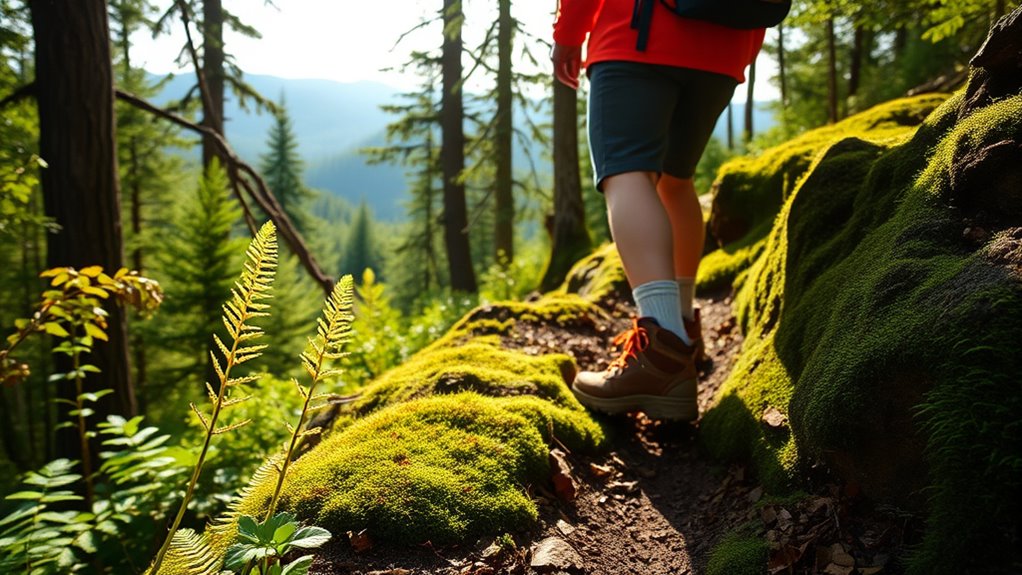
Educating and inspiring fellow hikers is essential for preserving the trail’s future. By sharing your knowledge of trail etiquette, you encourage respectful behavior that protects the environment and enhances everyone’s experience. For example, remind others to pack out trash, yield to uphill hikers, and keep noise levels low. Additionally, discussing gear selection helps promote safety and sustainability; suggest lightweight, eco-friendly gear that minimizes impact. Lead by example, demonstrating proper trail conduct and responsible gear use. When you engage in conversations about responsible hiking, you motivate others to follow suit. Your efforts can create a ripple effect, fostering a community committed to trail preservation. Incorporating proper gear maintenance tips can further extend the life of equipment and reduce waste. Together, through education and inspiration, you ensure that the Appalachian Trail remains a beautiful, accessible wilderness for generations to come.
Frequently Asked Questions
How Can I Support Conservation Efforts Along the Appalachian Trail?
You can support conservation efforts along the Appalachian Trail by practicing Leave No Trace principles, ensuring you leave nature undisturbed. Volunteer for trail restoration projects to help repair and maintain the trail’s integrity. Respect wildlife and stay on designated paths to prevent erosion. Additionally, advocate for policies that protect these natural areas. Your efforts keep the trail beautiful and sustainable for future hikers while preserving its ecological health.
Are There Specific Gear Recommendations for Eco-Friendly Hiking?
When choosing gear for eco-friendly hiking, focus on Leave No Trace principles by selecting sustainable, biodegradable, and durable equipment. Look for eco-friendly gear made from recycled or natural materials, like biodegradable soap and reusable utensils. Opt for lightweight, multi-use items to reduce waste and pack out all trash. By prioritizing eco-friendly gear, you help protect the environment and guarantee your hike remains sustainable for future adventurers.
What Are the Signs of Wildlife Distress Caused by Hikers?
You should watch for signs of wildlife distress caused by trail disturbance and changes in wildlife behavior. If animals appear more agitated, avoid eye contact, or try to retreat quickly, it indicates they’re stressed. You might notice birds stopping their songs or mammals becoming unusually alert. Respect their space by keeping noise levels down and sticking to designated paths. Recognizing these signs helps prevent further disturbance and promotes responsible trail use.
How Do Weather Conditions Influence Responsible Trail Use?
You might think weather safety is just about packing the right gear, but it also impacts trail use responsibly. Heavy rain, for instance, can cause trail erosion and make paths slippery, risking injury. Cold temperatures can lead to hypothermia if you’re unprepared. By respecting weather conditions and adjusting your plans, you help preserve the trail’s integrity and ensure everyone’s safety. Always check forecasts and adapt your hike accordingly.
Can Volunteering Help Maintain Trail Sustainability?
Volunteering greatly helps maintain trail sustainability by supporting Leave No Trace principles and trail stewardship. When you participate in trail work, you reduce erosion, repair damaged sections, and keep the environment pristine. Your efforts guarantee future hikers can enjoy the trail responsibly. By actively engaging, you promote sustainable use, protect natural resources, and foster a community dedicated to preserving the trail’s beauty and integrity for generations to come.
Conclusion
By embracing these principles, you’ll help keep the trail’s natural beauty shining brightly for generations to come. Your mindful choices guarantee the land remains vibrant, inviting others to experience its wonder. When you tread lightly and respect the wilderness, you become a gentle guardian of the Appalachian’s treasures. Remember, each step you take can quietly weave a story of stewardship, inspiring others to follow your lead and cherish this pristine landscape just as you do.

